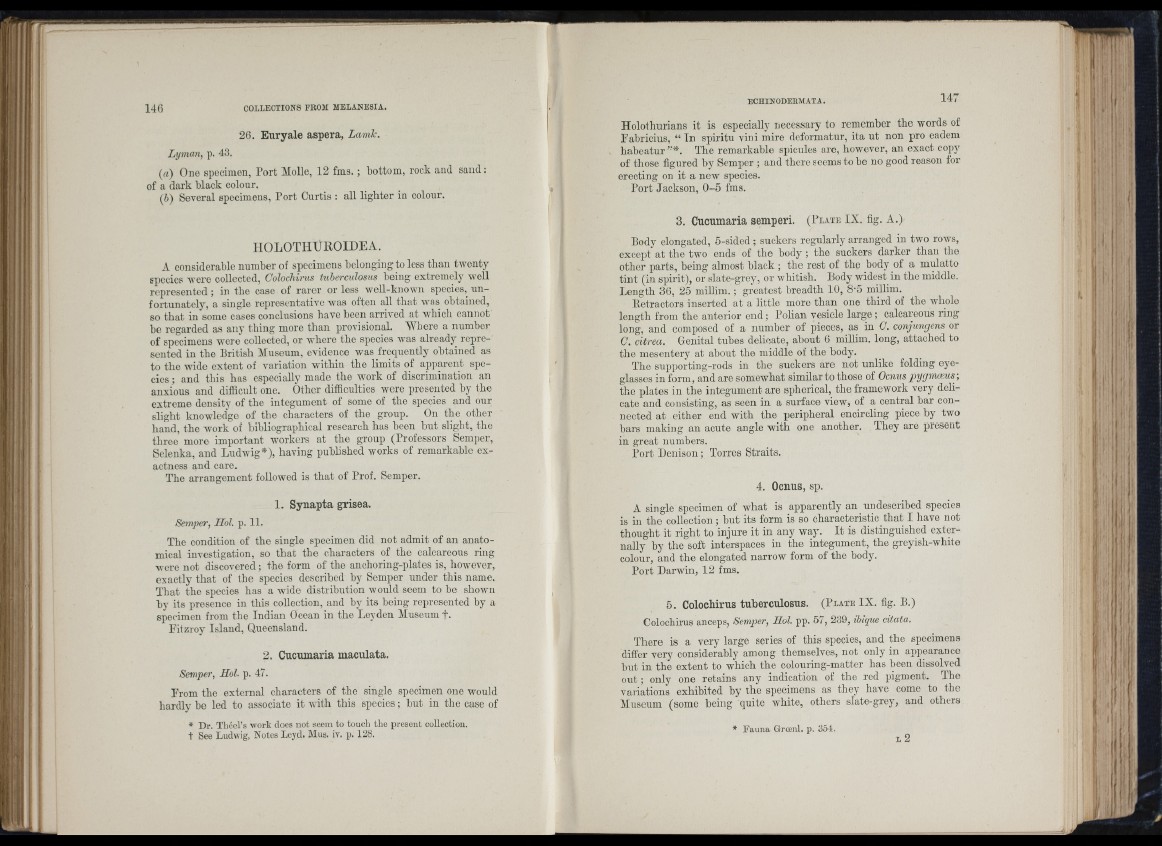
! : i'i I
!! I
ii iN'
‘ft
' I !
If
H I
M il
a
26. Euryale aspera, Lamie.
Lyman, p. 43.
(rt) One specimen, Port Molle, 12 fms. ; bottom, rock and sand :
of a dark black colour.
(6) Several specimens, Port Curtis : all lighter in colour.
HOLOTHUROIDEA.
A considerable number of specimens belonging to less than twenty
species were collected, Colochirus tuberculosus being extremely well
represented ; in the case of rarer or less well-known species, unfortunately,
a single representative was often all th at was obtained,
so th at in some cases conclusions have been arrived at which cannot
be regarded as any thing more than provisional. Wliere a number
of specimens were collected, or where the species was already represented
in the British Museum, evidence was frequently obtained as
to the wide extent of variation within the limits of apparent species
; and this has especially made the work of discrimination an
anxious and difficult one. Other difficulties were presented by the
extreme density of the integument of some of the species and our
slight knowledge of the characters of the group. On the other
hand, the work of bibliographical research has been hut slight, the
three more important workers at tho group (Professors Semper,
Selenka, and Ludwig*), having published works of remarkable exactness
and care.
The arrangement followed is th at of Prof. Semper.
1. Synapta grisea.
Semper, Hoi. p. 11.
The condition of the single specimen did not admit of an anatomical
investigation, so th at the characters of the calcareous ring
were not discovered; the form of the anchoring-plates is, however,
exactly th at of the species described by Semper under this name.
That tho species has a wide distribution would seem to he shown
by its presence in this collection, and by its being represented by a
specimen from the Indian Ocean in the Leyden Museum f .
Fitzroy Island, Queensland.
2. Cucumaria maculata.
Semper, Hoi. p. 47.
Phom the external characters of the single specimen one would
hardly be led to associate it with this species; hut in the case of
* Dr. Tlieel’s work does not seem to touch the present collection,
t See Ludwig, Notes Leyd. Mus. iv. p. 128.
Holothurians it is especially necessary to remember the words of
Fabricius, “ Tn spiritu vini mire deformatur, ita u t non pro eadem
hahcatur ’•'*. The remarkable spicules are, however, an exact copy
of those figured by Semper ; and there seems to be no good reason for
erecting on it a new species.
Port Jackson, 0-5 fms.
3. Cucumaria semperi. (P la te IX. fig. A.)
Body elongated, 5-sided; suckers regularly arranged in two rows,
except at the two ends of the body ; the suckers darker than the
other parts, being almost black ; the rest of the body of a mulatto
tin t (in spirit), or slate-grey, or whitish. Body widest in the middle.
Length 36, 25 millim.; greatest breadth 10, 8-5 millim.
Betractors inserted at a little more than one third of the whole
length from the anterior e n d ; Pollan vesicle large ; calcareous ring-
long, and composed of a number of pieces, as in C. conjungens or
0. citrea. Oenital tubes delicate, about 6 millim. long, attached to
the mesentery at about the middle of the body.
The supporting-rods in the suckers are not unlike folding eyeglasses
in form, and are somewhat similar to those of Ocnus pygmaeus',
the plates in the integument are spherical, the framework very delicate
and consisting, as seen in a surface view, of a central bar connected
at cither end with the peripheral encircling piece by two
bars making an acute angle with one another. They are present
in great numbers.
Port Denison ; Torres Straits.
ll i
i I
4. Ocnus, sp.
A single specimen of what is apparently an _undescribed species
is in the collection ; hut its form is so characteristic th at I have not
thought it right to injure it in any way. I t is distinguished externally
by the soft interspaces in the integument, the greyish-white
colour, and the elongated narrow form of the body.
Port Darwin, 12 fms.
5. Colochirus tuherculosus. (P late IX. fig. B.)
Colochirus anceps, Semper, Hoi. pp. 57, 239, ibique citata.
There is a very large series of this species, and the specimens
differ very considerably among themselves, not only in appearance
hut in the extent to which the colouring-matter has been dissolved
o u t ; only one retains any indication of the rod pigment. Ih e
variations exhibited by the specimens as they have come to the
Museum (some being quite white, others slate-grey, and others
* Fauna Groenl. p. 354.
Ihi
( I
i Ii